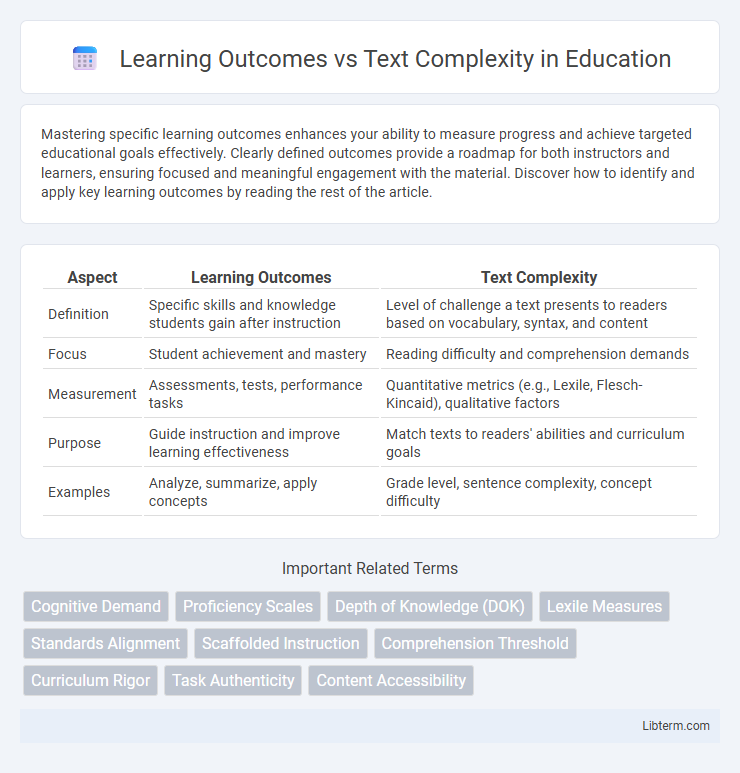Mastering specific learning outcomes enhances your ability to measure progress and achieve targeted educational goals effectively. Clearly defined outcomes provide a roadmap for both instructors and learners, ensuring focused and meaningful engagement with the material. Discover how to identify and apply key learning outcomes by reading the rest of the article.
Table of Comparison
| Aspect | Learning Outcomes | Text Complexity |
|---|---|---|
| Definition | Specific skills and knowledge students gain after instruction | Level of challenge a text presents to readers based on vocabulary, syntax, and content |
| Focus | Student achievement and mastery | Reading difficulty and comprehension demands |
| Measurement | Assessments, tests, performance tasks | Quantitative metrics (e.g., Lexile, Flesch-Kincaid), qualitative factors |
| Purpose | Guide instruction and improve learning effectiveness | Match texts to readers' abilities and curriculum goals |
| Examples | Analyze, summarize, apply concepts | Grade level, sentence complexity, concept difficulty |
Understanding Learning Outcomes in Education
Understanding learning outcomes in education is essential for aligning curriculum design with student achievement, ensuring clear expectations for knowledge, skills, and attitudes acquired by learners. Text complexity plays a crucial role in shaping these outcomes by influencing reading comprehension, critical thinking, and engagement levels required to master educational objectives. Effective assessment of text complexity supports targeted instructional strategies that enhance learning outcomes across diverse student populations.
Defining Text Complexity: Key Factors
Defining text complexity involves evaluating quantitative measures such as word frequency and sentence length, qualitative factors including levels of meaning and text structure, and reader-task considerations like prior knowledge and motivation. These key factors interact to determine the text's appropriateness for specific learning outcomes and student reading abilities. Accurate assessment of text complexity supports targeted instruction and improved comprehension development.
The Relationship Between Learning Outcomes and Text Complexity
The relationship between learning outcomes and text complexity is critical for designing effective educational materials, as appropriately challenging texts enhance comprehension and critical thinking skills. Text complexity, measured through factors such as vocabulary difficulty, sentence structure, and conceptual density, must align with learners' reading proficiency to support optimal learning outcomes. Research indicates that when learning materials are matched to students' reading levels, engagement and retention improve, leading to higher academic achievement and skill development.
Importance of Aligning Learning Goals with Text Difficulty
Aligning learning goals with text complexity ensures that students engage with materials suited to their cognitive and reading abilities, promoting effective comprehension and skill development. Appropriately challenging texts foster critical thinking and deeper understanding without causing frustration or disengagement. This alignment enhances learning outcomes by providing scaffolded experiences that gradually build students' proficiency and confidence.
Strategies for Assessing Text Complexity
Effective strategies for assessing text complexity involve analyzing quantitative measures such as Lexile scores and qualitative aspects like theme, language structure, and knowledge demands. Incorporating reader and task considerations, including students' background knowledge and purpose for reading, ensures alignment with learning outcomes. Utilizing rubrics and frameworks like the Common Core State Standards' model helps educators select appropriately challenging texts that promote comprehension and critical thinking.
Matching Instructional Materials to Desired Learning Outcomes
Matching instructional materials to desired learning outcomes requires aligning text complexity with students' cognitive abilities to maximize comprehension and engagement. Texts that are appropriately challenging foster critical thinking and deeper understanding, directly supporting measurable learning objectives. Careful calibration of reading levels ensures that materials neither overwhelm nor under-stimulate learners, optimizing educational effectiveness.
Challenges in Balancing Text Complexity and Student Proficiency
Balancing text complexity with student proficiency presents challenges in achieving optimal learning outcomes, as texts that are too difficult can hinder comprehension and engagement. Educators must carefully select materials that align with students' reading levels while promoting vocabulary and critical thinking development. Inadequate matching of text complexity to student ability often results in decreased motivation and limited academic growth.
Supporting Diverse Learners with Varied Texts
Supporting diverse learners requires aligning learning outcomes with appropriately complex texts that match students' reading abilities and interests. Differentiated instruction using varied texts--from simple narratives to advanced informational content--enhances comprehension and engagement for learners across proficiency levels. Strategic text selection based on complexity metrics and targeted learning goals ensures equitable access to challenging, meaningful literacy experiences.
Measuring Student Progress: Learning Outcomes and Text Analysis
Measuring student progress effectively requires aligning learning outcomes with appropriate text complexity levels to ensure accurate assessment of reading comprehension and critical thinking skills. Utilizing text analysis tools, educators can evaluate readability, vocabulary, and syntactic difficulty, enabling tailored instruction that meets individual student needs and benchmarks learning outcomes. Tracking performance against these metrics provides actionable insights into student growth and instructional effectiveness.
Best Practices for Integrating Complex Texts into Curriculum
Integrating complex texts into curriculum requires strategic scaffolding to align with intended learning outcomes, ensuring students develop critical thinking and analytical skills. Best practices emphasize selecting texts with appropriate Lexile measures and providing targeted frontloading of vocabulary and background knowledge to enhance comprehension. Consistent formative assessments guide instruction and help adjust text difficulty, fostering progressive mastery of complex materials aligned with standards.
Learning Outcomes Infographic

 libterm.com
libterm.com